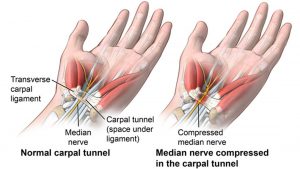

Mount Sinai Hospital: (305) 921-4679
Aventura Hospital: (305) 604-3216
Memorial Hospital: (305) 604-3216
The Carpal Tunnel is a canal in the wrist bound by bones and ligaments through which a multitude of nerves pass on their way to the hand. Carpal tunnel syndrome is one of the more common disorders of the hand and wrist. It occurs from nerve compression of the nerves in this tunnel in the wrist. The median nerve is usually the nerve affected. The doctor can identify if you suffer from carpal tunnel syndrome by a combination of your symptoms cluster and a physical exam. Additionally, to confirm the diagnosis objectively, a nerve study—requiring a referral to a neurologist—is usually recommended.
When the median nerve is compressed, this may cause pain, numbness, tingling, weakness, cramps, or clumsiness in the hand. Most people experience these symptoms in the thumb, index, middle, and ring fingers. Overall, it has been noted that the pain gets worse at night.
Treatment options include medications, splinting, injection, or surgery. Surgery involves releasing the ligament thereby enlarging the carpal tunnel and thus, giving the nerve more space. Surgery can be performed “open” requiring a 2-3 cm incision on the wrist or “endoscopic” which is a minimally invasive technique with a smaller 1 cm incision allowing for quicker recovery and less down time. In most cases, this can be done with just mild sedation and local anesthesia.

If you would like more information on carpal tunnel syndrome, we invite you to review an educational website endorsed by the American Academy of Orthopaedic Surgeons.
© MOSA Surgery. All Rights Reserved. | Accessibility Policy
Last Updated: January 26th, 2021 11:03 AM